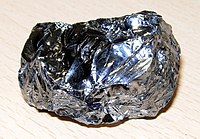
Photo from wikipedia
Abstract. Global climate change leads to simultaneous changes in multiple environmental drivers in the marine realm. Although physiological characterization of coccolithophores has been studied under climate change, there is limited… Click to show full abstract
Abstract. Global climate change leads to simultaneous changes in multiple environmental drivers in the marine realm. Although physiological characterization of coccolithophores has been studied under climate change, there is limited knowledge on the biochemical responses of this biogeochemically important phytoplankton group to changing multiple environmental drivers. Here, we investigate the interactive effects of reduced phosphorus availability (4 to 0.4 µmol L−1), elevated pCO2 concentrations (426 to 946 µatm), and increasing light intensity (40 to 300 µmol photons m−2 s−1) on elemental content and macromolecules of the cosmopolitan coccolithophore Emiliania huxleyi. Reduced phosphorus availability reduces particulate organic nitrogen (PON) and protein contents per cell under 40 µmol photons m−2 s−1 but not under 300 µmol photons m−2 s−1. Reduced phosphorus availability and elevated pCO2 concentrations act synergistically to increase particulate organic carbon (POC) and carbohydrate contents per cell under 300 µmol photons m−2 s−1 but not under 40 µmol photons m−2 s−1. Reduced phosphorus availability, elevated pCO2 concentrations, and increasing light intensity act synergistically to increase the allocation of POC to carbohydrates. Under elevated pCO2 concentrations and increasing light intensity, enhanced carbon fixation could increase carbon storage in the phosphorus-limited regions of the oceans where E. huxleyi dominates the phytoplankton assemblages. In each type of light intensity, elemental-carbon-to-phosphorus (C:P) and nitrogen-to-phosphorus (N:P) ratios decrease with increasing growth rate. These results suggest that coccolithophores could reallocate chemical elements and energy to synthesize macromolecules efficiently, which allows them to regulate their elemental content and growth rate to acclimate to changing environmental conditions.
Journal Title: Biogeosciences
Year Published: 2023
Link to full text (if available)
Share on Social Media: Sign Up to like & get
recommendations!